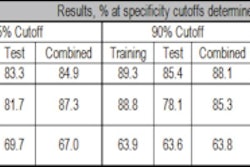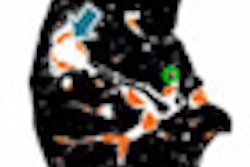The use of CT angiography (CTA) for head and neck indications has gone through the roof in the past few years -- rising by more than 800% between 2002 and 2007 in the Medicare population, according to a new study in the November issue of the Journal of the American College of Radiology.
There were also modest drops in invasive angiography use during the same period, but the use of MR angiography (MRA) and carotid ultrasound continued to grow. The results suggest that even as providers rush to order head and neck CT scans, most represented additional use of advanced imaging rather than a replacement for studies performed on more traditional modalities (JACR, November 2010, Vol. 7:11, pp. 854-858).
"The basic message is that CTA is becoming a lot more widely used than MRA," co-author David Levin, MD, from Thomas Jefferson University in Philadelphia told AuntMinnie.com in an interview. "From 2002 to 2007, head CT increased by more than 800% and head MRA by only 39%, and basically the same thing happened with neck CTA, which was up by over 1,000% compared to neck MRA up by 31%."
Long-term trend
Lead author David Freeman, MD, along with Levin and Vijay Rao, MD, noted that advanced imaging rates have been rising for a couple of decades, not just the six years documented by the study.
Rising with utilization has been growth in ionizing medical radiation, which grew more than sevenfold between the early 1980s and 2006, "an increase attributable largely to the dramatic growth in the diagnostic capabilities and use of CT," they noted.
The study analyzed trends in the utilization of CTA and MRA of the head and neck over the six years between 2002 and 2007, adding, for perspective, procedure volumes for duplex ultrasound of the carotid arteries and conventional craniocervical carotid and vertebral angiography.
By restricting the study to a small number of head and neck procedures in a Medicare population, the authors said they hoped to gain insight into whether one test replaced another or is merely additive to the total, and whether the use of contrast is increasing as a result of higher image utilization.
The study looked at Medicare Part B data for 2002 through 2007, examining eight CPT codes including those for head CTA (70496) and neck CTA (70498), MRA without contrast (head, 70544; neck, 70547), MRA with contrast (head, 70545; neck, 70548), and studies without and with contrast (head, 70546; neck, 70549). The results were analyzed by CPT code year by year and modality by modality, and data were analyzed regarding contrast utilization and costs.
Between 2002 and 2007, the volume of head CTA scans increased steadily from 8,987 to 83,297 (+827%), and the volume of head MRA increased 39% from 272,387 to 377,820 exams. The percentage increase declined during the study period, however, and most of the 39% increase in MRA actually occurred between 2002 and 2005, the authors wrote. During the study period, the volume of all head exams in both modalities increased by 64%. At the same time, exams using contrast increased by 235%. In 2002, 23% of examinations used contrast; in 2007, 46% of examinations used contrast.
Change in Medicare exam rates: 2002-2007
|
"These data suggest that head and neck CTA is replacing head and neck MRA for many patients," Freeman and his team wrote. "However, the volume of head and neck MRA increased by > 10% per year from 2002 to 2005, and the rate of growth of head and neck CTA increased by > 20% per year from 2005 to 2007. Hence, although one modality [CTA] seems to be partly replacing another [MRA], growth in the volume of neurovascular imaging in the Medicare population using costly, advanced imaging modalities continued unabated."
The rise of screening
Utilization has been rising for multiple reasons, including technologic advances, changes in best practice guidelines, self-referral, an aging population, patient expectations, and medicolegal concerns, the authors stated. But according to Levin, the biggest reason for the surge reported in the study is probably the growing use of imaging for screening.
"There's a lot more screening going on now, and carotid ultrasound is an excellent way to screen for carotid artery disease in the neck," Levin said. "That's leading to more follow-up studies" using CTA, and, far less frequently, MRA."
Another factor is that improved technology has lowered the threshold for intervention, Levin said. These days, if a physical exam finds a carotid bruit and follow-up ultrasound finds some degree of stenosis at the carotid bifurcation, the patient can be referred for intervention, Levin said. In the old days, workup meant angiography "and the threshold was much higher because it was an invasive study," he said. Now, the CTA or MRA workup is completely noninvasive.
What's more, new minimally invasive exams are facilitating the treatment of some patients who wouldn't have been surgical candidates in the past, and CTA is also being used to evaluate hyperacute infarction.
The authors cited technical improvements in CT as another reason for its dramatic growth and the decline of angiography. "Indeed, for many indications, clinicians and radiologists now regard CTA as a surrogate for conventional angiography; from the perspective of patient safety and comfort, this represents a tremendous improvement," they wrote.
But the majority of the growth in CTA is clearly "unrelated to its substitution for conventional angiography; anecdotally, this corroborates the experience in our own academic neuroradiology practice," they wrote.
There was a strong trend toward the use of contrast-enhanced head and neck MRA studies between 2002 and 2007 -- and these studies typically use a high volume of gadolinium-based contrast agents, they wrote. This, combined with head and neck CTA's growth, accounts for the increase of 235% in contrast-enhanced studies, and an increase of 203% in their costs.
"Clearly, the elderly Medicare population is now receiving markedly more contrast material to noninvasively assess the arterial vasculature of the head and neck," they wrote. "Caution is needed inasmuch as older patients are more prone to chronic kidney disease."
The authors noted that CTA growth means increases in radiation exposure, and the typical indications for CTA (intracranial aneurysm and carotid stenosis) are applicable to younger patients more vulnerable to radiation as well as the Medicare population examined in the study.
Growth of 20% in carotid ultrasound undoubtedly helped fuel CTA growth "as some patients will require corroboration of ultrasound findings or further anatomic evaluation," Freeman and colleagues wrote.
Better outcomes?
From Medicare records, it's impossible to know if outcomes have improved as a result of the increases in advanced imaging, the team noted. Nor can it be known if complication rates have been cut or if contrast has led to more of them, or if incidental findings led to the need for more studies.
Medicare records can't determine if CTA and MRA are being used instead of duplex ultrasound to examine the carotid arteries. And the data do not say whether incidental findings such as small aneurysms in the elderly population are being overtreated.
"The answers to many of these questions fall into the realm of evidence-based medicine, and they are extremely important," the authors wrote. "In the current economic and healthcare climate, insurers and politicians will certainly want to know what gains are being achieved for any increase in cost."
It won't be easy to measure outcomes using Medicare data, Levin said in his interview, but there are other routes to more information. "I would say we probably ought to research the costs of the workup and maybe total hospital time," he said. Hospital days may well have decreased with the increase in CT use because CTA is noninvasive compared to angiography, which required a separate hospital admission, he said.
The authors have another study coming out in early 2011 showing CT utilization rates for most indications beginning to decline after 2006. Levin said the data contain no specific information on head and neck CT, adding that in his estimation, the use of head and neck CT won't decline with other CT applications going forward.
By Eric Barnes
AuntMinnie.com staff writer
November 9, 2010
Related Reading
GAO numbers overstate growth in medical imaging, May 4, 2010
GAO takes on self-referral study, April 29, 2010
Medicare cancer imaging grows at twice rate of overall expenses, April 27, 2010
Final answer on equipment use rate: 75% in 2011, March 26, 2010
Study offers more nuanced views of U.S. imaging use rates, March 22, 2010
Copyright © 2010 AuntMinnie.com



















